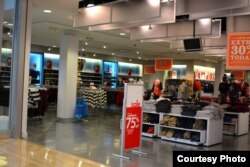The U.S. holiday shopping season is off to a good start. The 4-day long Thanksgiving weekend (Nov 24-27) which unofficially kicks off the shopping season, brought in a total of $9.36 billion in sales, up 16% from the previous year.
Online sales fueled a big part of the increase. Adobe Digital Insights, which tracks credit card purchases, says $4.1 billion came from online sales, nearly 15% higher than the same period last year.
First Data, another online analytics group, says e-commerce accounted for roughly 25 percent of holiday dollars spent over the holiday weekend. Last year e-commerce accounted for 18% of the weekend haul.
Old fashioned brick and mortar stores also saw increased traffic with sales growth of 8.6% year over year, according to Adobe Digital Insights.
Adobe Digital analyst Tamara Gaffney says most online purchases were made either from tablets and smartphones, and the majority of e-commerce purchases were made by millennials - those between the ages of 19 to 34.
Gaffney says many millennials told her they were more inclined to shop for Black Friday deals online to avoid big crowds. She says many also believed they could get better deals online without having to wait through long lines.
“But also they just really, really like to be online and they’re very comfortable with mobile shopping,” Gaffney said.
'Buy button'
Cyber Monday, the first full working day after the holiday weekend, also broke new ground, posting the largest online sales for a single day with $3.5 billion. That’s a new record, said Gaffney, adding that online consumers not only bought more, they also spent more - about 12 percent more than the previous year and nearly 3% more than Adobe’s initial forecast.
“They were pushing the buy button" at a rate 1 percent higher than normal, Gaffney said, "which in retail is a big deal.”
Black Friday, so called because it marks the day when retailers shift into profit mode, is also a very big deal for online retailer Amazon.
Tom Vanthournout, the director of Amazon’s fulfillment center in Haslet, Texas, said the center is working at full speed. The 1 million-square-foot facility north of Fort Worth employs about 3,000 people.
“We’ve been really excited and planning for this day (start of the holiday shopping season) for over 10 months, so this is really the culmination of that, and it’s really, like I said, our Super Bowl event," Vanthournout said.
While the increase in online sales could reduce in-store traffic over time, First Data analytics says that doesn't seem to be the case at electronics and appliance stores, which saw a 26% increase in sales. NRF says a recent survey shows that’s because consumers still prefer to buy TVs and electronic appliances in person.
The holiday shopping season is key to survival for retailers, accounting for as much as half of the entire profit for the year at some stores.
About 154 million consumers went shopping over the Thanksgiving weekend, up from 151 million in 2015. And Gaffney says the season is just getting started.
"There is a lot of shopping going on still. It doesn’t seem like the appetite has run out yet," she said. "We’re expecting a little over a 9 percent year-over-year increase."
NRF estimates consumers will spend about $656 billion between November and December. That’s an increase of about 3.5 percent more than in 2015. However the same survey suggests consumers say they plan to spend less than they did in 2015 -- about $935 per person, down from $952 last year.








